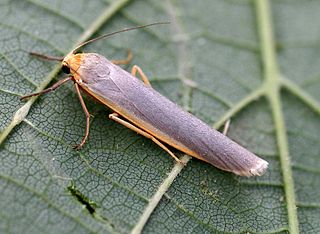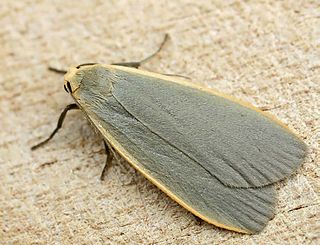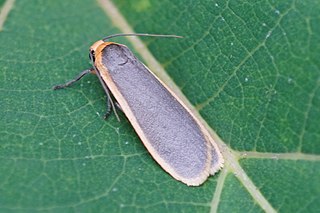Collita is a genus of moths in the family Erebidae. The genus was erected by Frederic Moore in 1878.

Eilema is a genus of moths in the subfamily Arctiinae. The genus was erected by Jacob Hübner in 1819.

Manulea complana, the scarce footman, is a moth of the family Erebidae. The species was first described by Carl Linnaeus in his 1758 10th edition of Systema Naturae. It is found throughout the Palearctic region.

Katha depressa, the buff footman, is a moth of the family Erebidae found in Asia and Europe. It was first described by Eugenius Johann Christoph Esper in 1787.

Collita griseola, the dingy footman, is a moth of the family Erebidae. The species was first described by Jacob Hübner in 1803. It is found in Europe and North and South-East Asia.

Wittia sororcula, the orange footman, is a moth of the family Erebidae. The species was first described by Johann Siegfried Hufnagel in 1766. It is found in Europe, Anatolia and further east across the Palearctic to southern Siberia and the Amur basin to China.

Eilema caniola, the hoary footman, is a moth of the family Erebidae. The species was first described by Jacob Hübner in 1808.

Eilema lutarella is a species of moth in the family Erebidae. It is found in North Africa through Central Europe up to the area surrounding the Amur River and Sakhalin. In the north, it is found up to Scandinavia, Komi Republic in European Russia, Vitim river in Siberia.

Manulea (Setema) cereola is a moth of the family Erebidae. It is found in Fennoscandia, the Baltic States, European Russia as well as the Alps and Urals. The species was first described by Jacob Hübner in 1803.
Dolgoma cribrata is a moth of the family Erebidae first described by Otto Staudinger in 1887. It is found in eastern Asia, more specifically Russia, China, Korea and Japan.
Collita vetusta is a moth of the family Erebidae. It is found in Japan, the Russian Far East, northern China and Korea.
Collita coreana is a moth of the family Erebidae. It is found in Korea. Records for the Russian Far East and Japan are probably based on misidentifications of Manulea ussurica.
Collita gina is a moth of the family Erebidae. It is found in Japan.
Collita okanoi is a moth of the family Erebidae. It is found on the southern Kuriles and in Japan.
Collita chinensis is a moth of the family Erebidae. It is found in Mongolia and China.
Manulea flavociliata is a moth of the family Erebidae. It is found in north-eastern Kazakhstan, southern Siberia, the Russian Far East, Mongolia, China and Korea.
Manulea pseudofumidisca is a moth of the family Erebidae. It is found in Russia, North Korea and China.

Manulea japonica is a moth of the family Erebidae. It is found on the Kuril Islands (Kunashir) and in China, Korea and Japan. It has a wingspan of 25–30 mm.
Manulea omelkoi is a moth of the family Erebidae. It is found in the Russian Far East.

The Lithosiina are a subtribe of lichen moths in the family Erebidae. The taxon was erected by Gustaf Johan Billberg in 1820.









